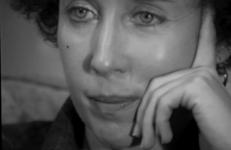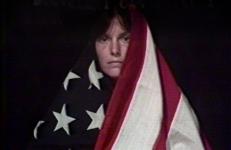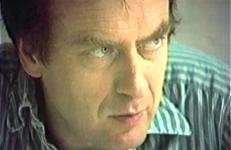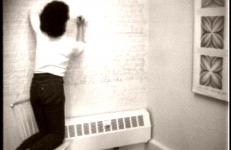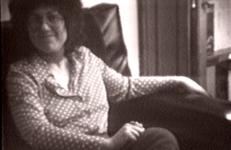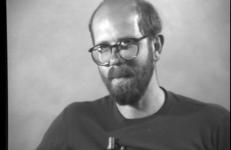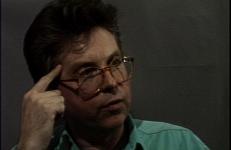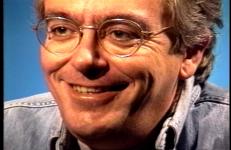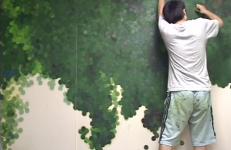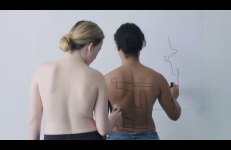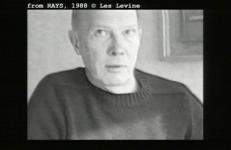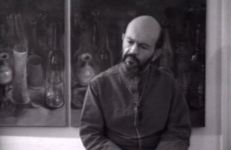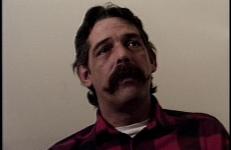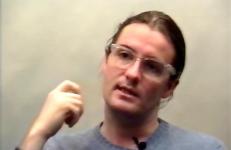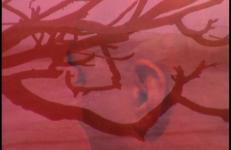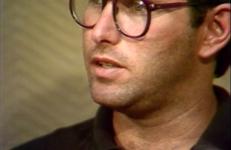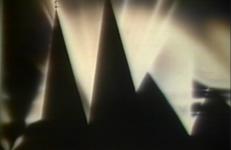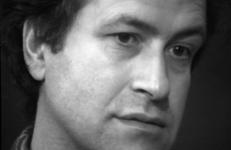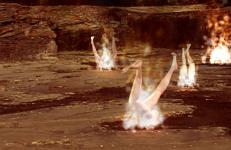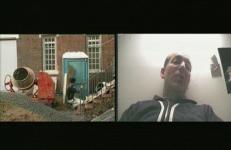California-based painterJoan Brown (1938-1990) attended the California School of Fine Arts (now the San Francisco Art Institute). Brown has long been recognized as one of the most important artists to emerge from the creative milieu of the San Francisco Bay Area of the late 1950s. She created a body of work distinguished by its breadth and personal vision. Brown’s style incorporated abstract expressionism and figurative painting. One of California's pre-eminent figurative artists, she died in at the age of 52, in India.
Visual Art
In this interview video and performance artist Nancy Buchanan discusses her feminist and political work. Buchanan comments upon the advantages of video over performance in terms of accessibility—the ability for her videos to circulate and reach audiences she physically cannot, and their brevity and completed form—and her strategies to create an atmosphere for change. This Video Portrait features two of Buchanan’s videos in their entireties: the anti-nuclear weapons work An End to All Our Dreams (1982) and the more straightforwardly feminist Webs (1983).
Benjamin Buchloh is an influential art critic and historian; he has written extensively on contemporary art for journals and exhibition catalogs, as well as his essay collection Neo-Avantgarde and Culture Industry (2002). This interview with Buchloh is one of several collected by Antonio Muntadas for his series Between the Frames. In this video Buchloh discusses the relationship between people and institutions.
"We buried ten Cadillacs in a row alongside Interstate 40 (the old Route 66), just west of Amarillo, Texas; each car represented a model change in the evolution of the tail fin. This was clearly a sculptural act, but with a minimal amount of formal manipulation. Media Burn, created a year later in San Francisco, was a live performance. It was a spectacle staged for the camera culminating in the 4,000 pound Phantom Dream Car crashing through a pyramid of TV sets to the cheers of the audience of 400.
Judy Chicago (b.1939) is an artist, author, feminist, educator, and intellectual whose career now spans four decades. In 1974, Chicago turned her attention to the subject of women’s history to create her best known work, The Dinner Party, which was executed between 1974 and 1979 with the participation of hundreds of volunteers. This monumental multimedia project, a symbolic history of women in western civilization, has been seen by more than one million viewers during its 16 exhibitions held at venues spanning six countries.
Judy Chicago (b.1939) creates large-scale, collaborative artwork has brought greater prominence to feminist themes and craft arts such as needlework and ceramics. Her most famous work, The Dinner Party (1979), was an enormous collaboration with hundreds of volunteers including ceramicists, china painters and needleworkers. The monumental finished piece has place settings for 39 mythical and historical famous women, writing them back into the heroic history usually reserved for men. Earlier in her career, Chicago was part of the Finish Fetish movement within Minimalism.
Chuck Close (b.1940) has been a leading figure in contemporary art since the early 1970s. As a young artist in the mid-’60s, Close turned away from the model of Abstract Expressionism to develop a simple but labor-intensive working method based upon repetition and small color elements. Denying himself expressive gesture, Close builds shapes and tonal variations within a working grid that provides the structure for large-scale, close-up portraits. Close’s formal analysis and methodological reconfiguration of the human face have radically changed the definition of modern portraiture.
John Arthur Clark (1943-1989) was born in Yorkshire, England. He attended Hull College of Art, receiving a National Diploma in Art and Design (N.D.D.) in painting. From 1966 to 1968 he attended Indiana University, receving an M.F.A. in painting. From 1968 to 1978 he was a lecturer in Fine Art and Art History at Hull College of Art and Newcastle Polytechnic. He emigrated to Canada in 1978 and became coordinator of painting and drawing at the Nova Scotia College of Art and Design.
Spanish painter Chema Cobo discusses his early years of studying and creating art in Southern Spain. His career began in the mid-1970s, exhibiting at the Buades and Vandrés galleries, along with a generation of now-established artists. His work began showing outside of Spain in the ’80s. Cobo also talks about the ways that his Spanish background and identity have informed his work.
A historical interview originally recorded in 1994.
Satoshi Uchiumi, Japanese abstract painter, believes that the beauty of painting lies within paint itself. He has pursued beauty by painting thousands of colored dots. He has also become known for his ability to highlight the relationship between the artwork, the exhibition space, and the viewer.
Following the premise that water will always find its level, the term Communicating Vessels describes the way liquid moves between conjoined containers: gravity and pressure conspire to keep the surfaces aligned, pulling the shared liquid back and forth until the separate vessels come into balance. Like the relationship between a mother and a child or fluid passed from mouth to mouth, meaning, intention and understanding constantly flow back and forth between us.
Following the premise that water will always find its level, the term Communicating Vessels describes the way liquid moves between conjoined containers: gravity and pressure conspire to keep the surfaces aligned, pulling the shared liquid back and forth until the separate vessels come into balance. Like the relationship between a mother and a child or fluid passed from mouth to mouth, meaning, intention and understanding constantly flow back and forth between us.
A portrait of the American artist Ray Johnson (1927-95), driving force behind the New York Correspondence School of the early 1960s. Ray Johnson was mainly known for his numerous mail art projects, involving artistic strategies like networks and collaboration. Key terms in his mail art activities were ADD TO AND RETURN, or SEND TO, inviting recipients to contribute to his work. Besides mail art, Ray Johnson worked on collages, assemblages, and performance throughout his life.
A portrait of the American artist Ray Johnson (1927-95), driving force behind the New York Correspondence School of the early 1960s. Ray Johnson was mainly known for his numerous mail art projects, involving artistic strategies like networks and collaboration. Key terms in his mail art activities were ADD TO AND RETURN, or SEND TO, inviting recipients to contribute to his work. Besides mail art, Ray Johnson worked on collages, assemblages, and performance throughout his life.
Uncomfortable journeys through the work and ideas of Christopher Cozier, a leading contemporary artist in the Caribbean. The video presents Cozier's witty and incisive drawings, installations and videos in the context of post-independence Trinidad with its oil-rich economy, complicated ethnic politics, and vibrant cultural forms.
Jim Dine (b. 1935) first emerged as an avant-garde artist creating Happenings and performances with Allan Kaprow, Claes Oldenburg, and others in the early 1960s. Ultimately, he rejected the performances that led to his early success in favor of an introspective search for identity. Using banal objects as subjects for his paintings and prints, Dine displayed a growing sense of self-awareness.
Felipe Ehrenberg is a prominent Mexican artist who has been actively producing interactive political art, installations, and murals for more than 30 years. Also a writer, Ehrenberg has run a small press in Mexico City and has published numerous articles for art journals in the United States.
Interview by Carol Becker.
Berlin-based Danish artist Olafur Eliasson complicates and simulates perception through his installations, sculptures, and photographs. He has created disorienting artificial illuminations and reproduced natural phenomena such as clouds, glaciers and the sun through large-scale, high-tech installations.
In Excerpts from Behold Goliath, Tom Kalin presents four experimental short films inspired by American writer Alfred Chester (1928-71), who in 1964 published a collection of short stories of the same name. Each of Kalin's films, Some Desperate Crime on My Head (2003), The Robots of Sodom (2002), Every Evening Freedom (2002), and Salad Days (2004), devotedly exploits Chester's words with computer voice-synthesizers, and juxtaposes them with music, film and hand-drawn images.
Eric Fischl's early works were large-scale abstract paintings. While teaching in Nova Scotia, Fischl began to shift from abstraction to smaller, image-oriented paintings, beginning with narrative works that investigated a fisherman's family. By the time Fischl left Halifax the narrative element was gone, but the subject of family melodrama remained. In the '80s Fischl's large figurative paintings, aggressive in their confrontation with the viewer, began to receive attention.
Hal Foster is Professor of Modern Art at Princeton University, and has written and edited numerous influential books on postmodernism, art, and culture. His books include Recodings: Art, Spectacle, Cultural Politics (1985); The Return of the Real: The Avant-Garde at the End of the Century (1996); and, as editor, The Anti-Aesthetic: Essays on Postmodern Culture (1983); Vision and Visuality (1988); and Richard Serra (2000).
Interview by David Raskin.
A historical interview originally recorded in 2001 and re-edited in 2008.
Painter and multi-media artist Jack Goldstein lived and worked in New York City. His airbrushed paintings of lightning and night skies are shown here accompanied by synthetic music, which the artist also composed. Goldstein committed suicide in 2003.
Interviewed by Jim Johnson.
Conceptual artist Hans Haacke’s two most notorious works took unsavory Manhattan real-estate dealing as their subject, which triggered the cancellation of his exhibition Real Time Social System at the Guggenheim Museum in 1971. With the conscientiousness of an investigative reporter, Haacke continues to scrutinize the rough edges between art and life.
Parnes moves further into her interrogation of horror genres and the art world, with their sometimes over-lapping cults of personality. Grappling with the danger of beauty without criticality, Hollywood Inferno takes the viewer through the alienating world of a teenager named Sandy, a modern-day Dante, and follows where her aspirations toward stardom lead her.
A comic monologue, I Was Once Involved in a Shit Show is a recollection of an imaginary art event that tallies with what most artists experience when they are involved in putting on an unfunded group show.




